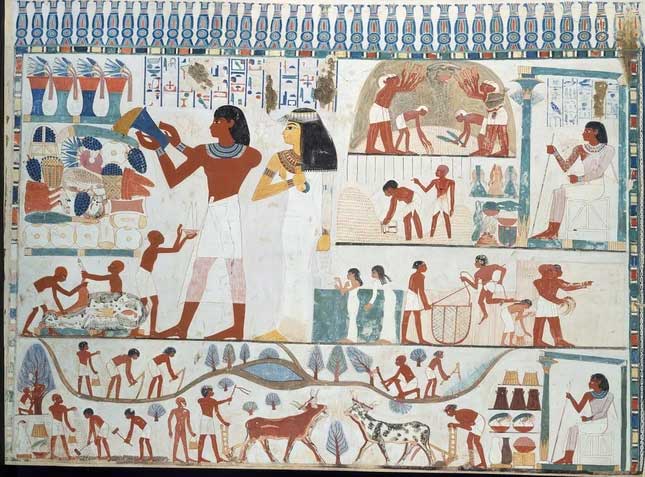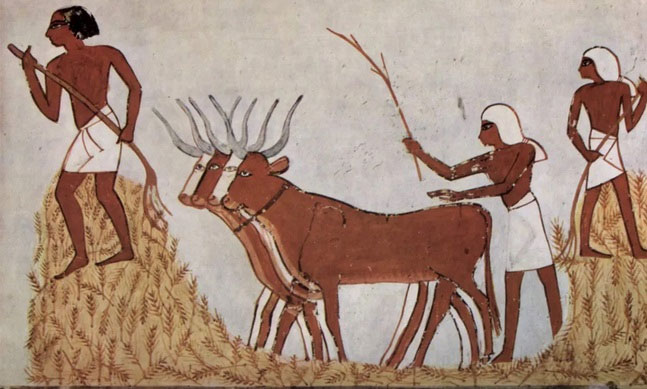Interesting things about taxes in ancient Egypt
Few people realize that, in addition to mummies and pyramids, the ancient Egyptians also left another very special legacy to this day, which is taxes and administrative management principles.
The ancient Egyptian civilization developed the world's first tax system around 3000 BC when Upper and Lower Egypt united to form the First Dynasty.

A copy of the agricultural drawing was found in the tomb of Nakht, a scribe and astronomer who lived during the reign of pharaoh Thutmose IV. (Photo: Wikimedia Commons)
Ancient Mesopotamia also soon learned from Egypt. The tax system has existed for millennia, remaining 'standing' after the fall of ancient Egypt in the first century BC and to this day.
While the ancient Egyptian tax system evolved and diversified throughout the civilization's existence, the basic concept remained the same: the state levied taxes to pay for its operations and maintain Social Order.
Egyptologist Toby Wilkinson at the University of Cambridge (UK) evaluates the legacy of ancient Egyptian government and the diverse tax system, from income taxes to customs duties, that can be clearly seen in modern versions. .
Mr Wilkinson explained: 'The fundamentals of human society have not changed in the last 5,000 years. You may recognize many management techniques invented in ancient Egypt that have remained unchanged to this day' .

Illustration of threshing rice in ancient Egypt. (Photo: Wikimedia Commons).
For most of its history, ancient Egypt taxed goods . Officials collected taxes in the form of grain, textiles, labor, livestock and other goods. The amount of tax payable was often related to agriculture, with a certain percentage of harvested agricultural products going to granaries or administrative storage centers operated by the dynasty.
Interestingly, the tax was adjusted according to yield , much like modern income tax brackets, with different categories established based on the amount of wealth generated. Mr. Juan Carlos Moreno Garcia at the French National Center for Scientific Research analyzed that, in general, fields with more successful harvests will be taxed at a higher rate.
He added: 'Fields are taxed in different ways and depend on productivity as well as soil fertility and quality. But the dynasty set a basic tax rate that depended on the height of the Nile's water level .
On Elephantine, an island in Upper Egypt, 19th-century archaeologists discovered a nilometer – a structure used to measure the water level of the Nile River. If water rises above a marked line, it portends flooded fields and poor harvests; If it drops too low, it means drought and crop failure.
Mr Wilkinson argued: 'Egypt is essentially an agricultural economy and is entirely dependent on the Nile River. We have records measuring the height of the Nile from the time of the First Dynasty, so we think this formed the basis of early taxation' .

Nilometer diagram of Elephantine Island. (Photo: Wikimedia Commons).
Harvest taxes provided an important source of revenue for the royal treasury. But the Egyptian dynasty needed not only grain but also labor. This was provided for under the corvée system, in which the crown could force all Egyptians below official rank to work on public projects, undertaking tasks such as plowing fields, mining and build temples and mausoleums.
In addition to determining tax rates and types of taxes, the ancient Egyptians also developed many methods of tax collection . During the Old Kingdom (from 2649 to 2130 BC), Egyptian pharaohs levied collective taxes on communities, ordering land owners to hand over the products obtained from their servants. Also around this time, the Egyptians pioneered the concept of a central government headed by the pharaoh, with smaller provinces called nomes, under local administration.
To ensure that nome leaders accurately reported local wealth, the pharaohs of the Old Kingdom often made annual or bi-annual visits. The voyages enabled kings to collect taxes directly rather than trusting third-party tax collectors or relying on the honesty of local governments.
By the time of the Middle Kingdom (2030 to 1650 BC), the pharaoh began to tax subjects on an individual level. The pharaoh's annual journey was no longer necessary; instead, there were scribes who kept meticulous records of how much tax was owed and who still needed to pay. This change in tax collection strategy was achieved due to a sudden increase in the literacy rate of the population.

Illustration of officials arresting farmers for forced labor because they did not pay taxes. (Photo: Wikimedia Commons).
Most evidence of the ancient Egyptian tax system comes from the peak period of record keeping - the New Kingdom (1550 to 1070 BC). During this period, there was always a strong force of tax collectors and scribes to ensure the Royal treasury was always full. Many of the New Kingdom's pharaohs used tax money to build large monuments and organize grand celebrations.
Notably, the ancient Egyptians not only invented the basis of tax administration but also its pitfalls, which are the concepts of fraud, tax evasion and corruption.
Scribes and governors often cooperated to underreport figures to the crown and then keep the surplus, or to charge farmers more taxes than they were due.
Meanwhile, taxpayers have circumvented the law to avoid having to contribute. For example, adjusting grain weighing calculations. Mr Wilkinson said: 'People would sneak stones into grain to meet the tax weight for their fields. The problem became so serious that royal decrees were issued ordering people not to cheat' .

Drawing of a harvest scene in an ancient tomb. (Photo: Wikimedia Commons).
Around the beginning of the 13th century BC, pharaoh Horemheb of the 18th Dynasty issued an edict stating that both tax extortion and tax evasion were punishable by amputation and exile. This declaration reaffirmed the people's obligation to pay taxes to the pharaoh, as everything in the country was considered to belong to the pharaoh.
Although the reality of ancient Egyptian society revolved around a firm belief in the pharaoh, who was considered a mediator between humanity and the gods, ordinary people of that period even openly opposed paying taxes. Some complaints focus on unfair tax assessments.
Egyptians grew dissatisfied with the tax system after foreign occupation combined with the introduction of hard currency in the mid-first millennium BC. When the Persians and later the Macedonians occupied Egypt, they issued coins and levied taxes on the native population.
Egyptians complain about paying taxes to the occupiers, and they also complain about official corruption and stealing. During King Ptolemy V's accession to the throne around 204 BC, the Egyptians rebelled against the occupying Macedonian army. Wanting to appease the Egyptian people, the Ptolemaic King sought to change tax rates for certain influential groups, such as high priests at major temples.
- Collect urine taxes, beard taxes and hundred odd things
- The truth about the tax 'nightmare' of ancient people
- 6 things we do not know about the people of ancient Egypt
- 10 interesting things about life you may not know
- Complete the dictionary of ancient Egypt
- Discover 10 interesting inventions of the ancient Egyptians
- Homosexuality in ancient Egypt
- Learn the disasters that destroyed ancient Egypt
- 10 interesting things about nature you may not know
- 3 everyday items you won't believe are from ancient Egypt
- Mysterious mysteries of ancient Egypt
- Interesting things about ancient castles in Europe
 'Fine laughs' - Scary and painful torture in ancient times
'Fine laughs' - Scary and painful torture in ancient times The sequence of numbers 142857 of the Egyptian pyramids is known as the strangest number in the world - Why?
The sequence of numbers 142857 of the Egyptian pyramids is known as the strangest number in the world - Why? History of the iron
History of the iron What is alum?
What is alum?